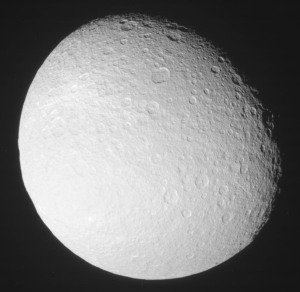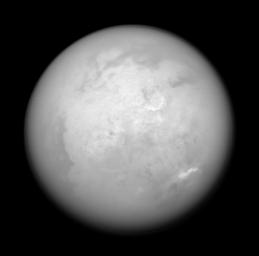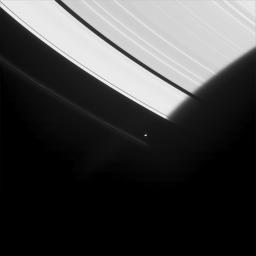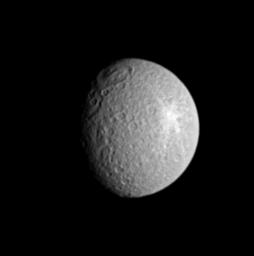 View of Enceladus an hour and a half before close approach (sub-spacecraft point: 47.75 South, 194.5 West). The map used is by Steve Albers (best online maps that include updated Cassini images). Phase angle at this time is 44 degrees so much of area near the bottom and to the right will be in darkness (terminator not shown here due to limitations in my available software). This plot was generated in ISIS. I have also created a plot using the online Saturn Viewer tool to show the terminator.
View of Enceladus an hour and a half before close approach (sub-spacecraft point: 47.75 South, 194.5 West). The map used is by Steve Albers (best online maps that include updated Cassini images). Phase angle at this time is 44 degrees so much of area near the bottom and to the right will be in darkness (terminator not shown here due to limitations in my available software). This plot was generated in ISIS. I have also created a plot using the online Saturn Viewer tool to show the terminator.
Enceladus-2 facts
- Occurs on July 14 at 1:19pm PDT
- Close Approach Distance = 169.4 km (lowered from 1000 km)
- Relative speed WRT Enceladus = 8.2 km/sec
- Closest Approach Lat and lon = 23.2 South, 325.4 West
- Low-phase inbound, high-phase outbound
- Phase Angle at T-2 hours: 46.7 degrees
It has been nearly 3 months since T5, the last Cassini targeted encounter of one of Saturn's many satellites. On Thursday, July 14, Cassini will fly within 175 km of the surface of the icy satellite Enceladus, the closest encounter of any target by Cassini thus far. This is the third close encounter with Enceladus: the first, a 1500-km non-targeted flyby on February 17, the second, a 500-km targeted encounter on March 9. Images from those two encounter taught Cassini scientists quite a bit about Enceladean geology and grain size distribution (course grain ice was found within outcrops along the walls of fresh fractures and ridges). Other instruments, like the magnetometer, the Cosmic Dust Analyser, and RPWS, provided tantalizing hints of an atmosphere and maybe even a magnetic field.
This week's encounter is designed to persue many of the unanswered questions left over from those two flybys as well as further explore question brought up by the data from earlier this year. This encounter was lowered in April from 1000 km to 170 km to explore the discoveries made by the magnetometer and other field-and-particles instruments. Data from these instruments improves as the altitude is lowered. These instruments will be looking at the particle environment of Enceladus by measuring the composition of the particles coming off Enceladus (CDA), by examining how that environment is modified through plasma and radiation bombardment (MIMI), or by examining the atmosphere (MAG). UVIS will also be looking at the density of the atmosphere by monitoring an occultation, during close approach, of gamma Orionis (Bellatrix) by the atmosphere and by Enceladus proper. UVIS failed to detect the atmosphere during an occultation of lambda Sco in February, though this was likely the result of using a poor occultation star. Bellatrix is much brighter in the UV range UVIS observes in and should provide better quality data compared to lambda Sco.
A few additional highlights of this flyby:
- ISS will image Enceladus throughout the encounter. ISS has major prime observations prior to close approach, observing the region above at 50 m/pixel to 1 km/pixel. This is the southern trailing hemisphere region of Enceladus. The trailing hemisphere was observed during the February and March encounters but the more southerly trajectory allows for improved viewing of the south polar region. As you can see in the plot above and in an image taken in May, there are four dark stripes (some with resolvable bright lanes in the middle) cutting through the south polar region (unofficially called "tiger stripes"). The nature of these stripes is still unknown. Higher resolution images taken in March suggest they might be ridges surrounded by blue material, but the ridge interpretation is suspect given the oblique viewing angle. Images from Thursday's encounter should help to resolve the issue. The rest of the region to be imaged was also seen earlier this year, but the differing viewing angles could provide an excellent stereo opportunity.
- INMS, normally associated with Titan observations, will be measuring the positive ion and neutral environments of Enceladus.
- VIMS will be preforming compositional mapping of the surface. Prior observations earlier this year found only water ice of varying grain size with none of the expected contaminants, like CO2 and Ammonia found. However, given the possible unusual nature of the south polar region, it is possible that VIMS might find non-ice materials there.
- UVIS, in addition to their gamma Orionis occultation, will be mapping the surface composition, focusing on the distribution of grain sizes on the surface. Water ice is dark at wavelengths less than 160 nm and turns bright over a range from 160 to 190 nm. Where the change in brightness takes place in the spectrum is diagnostic of the grain size.
- RADAR, another usual suspect for Titan, will be working in scatterometry mode to determine the roughness at centimeter scales. RADAR will also be in radiometry mode determining the energy balance of Enceladus.
- Early in the mission, Cassini Radio Science (RSS) determined that Enceladus was much denser than previously expected. At 1.6 g/cc, Enceladus must contain significant amounts of non-ice material in its interior. RSS will also use this flyby to further refine the mass estimate for Enceladus.
- CIRS will be preforming several scans of Enceladus' surface to determine the thermal and compositional characteristics which can be used to sample the regolith structure.
Given the wealth of data to be taken on this flyby, it is hoped that we will understand quite a bit more on how Enceladus' evolved, how it got to look so young in regions, and how Enceladus interacts with its environment. The observations also leave open the possibility of a serendipitous discovery, like a plume. The next close pass of Enceladus will take place in March 2008, when Cassini will pass within 100 km of the surface, even closer than this pass.
Enceladus isn't the only body that will be observed on this encounter. There are planned observations of Rhea and Epimetheus as well. Rhea will be observed by both RADAR and ISS during this Voyager-class distance encounter (~180,000 km).
This encounter will allow
imaging of the south polar region as well as the southern anti-Saturnian hemisphere, a region poorly observed by both Voyager and Cassini so far. This would also allow imaging of the circular moat and possible degraded impact basin seen in
today's daily release.
Epimetheus will also be observed on this orbit from a distance of 84,000 km, a
little farther and at higher phase than the
images taken in late March of this moon. This observation will also be a stereo opportunity, allowing for improved determination of Epimetheus' shape. These images will be taken after the Enceladus encounter.
Images and other data taken during the Enceladus, Rhea, and Epimetheus encounters will be returned on Friday, July 15. There will be two playback periods. The first runs from 12:14am till 3:04 am PDT, when the images from the Rhea encounter and perhaps the first of the Enceladus images will be returned. The second runs from 7:54am till 4:54pm, when the rest of the Rhea and Enceladus data will be returned as well as the Epimetheus images. Generally, raw images show up on the JPL raw image page several to 12 hours after the images are returned from the spacecraft though you can expect some select raw images could be posted on the CICLOPS website Friday afternoon.
Thanks to
Steve Albers for the map used in the plot above and to the PDS Rings Node for the
Saturn Viewer.










